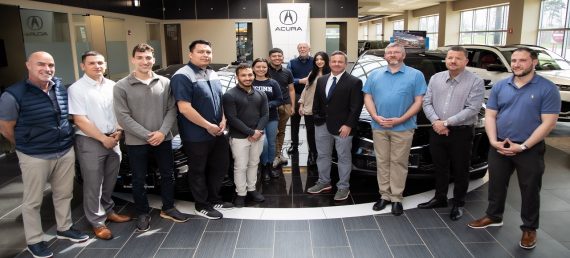Honda R&D Associates Develop New Uses For Old Denim
It has long been said that there is not much more comfortable than an old pair of jeans.
But as part of its ongoing commitment to recycling and reducing its environmental footprint, Honda is using discarded denim from jeans manufacturing to give its customers a quiet and comfortable ride in its automobiles.
At Honda R&D Americas, Inc. (HRA) in Raymond, Ohio, Product Development engineers are turning recycled post-industrial scrap material, such as fibers from jeans, into insulation and sound-absorbing materials for Honda and Acura vehicles. HRA associates and their partner suppliers found it to be an effective way to recycle waste while addressing vehicles’ wide-ranging requirements.
“The insulation needs alone are so different inside a vehicle, from their thickness to their densities and construction, that we have to consider all kinds of materials to meet those needs,” said Negar Gilsinger, a Material Sustainability Leader at HRA. “In a vehicle’s cabin alone, soft fiber insulators are designed to absorb different types of sound waves, from those coming from the engine to those coming from the road.”
Honda uses around 2,800 tons of post-industrial textiles each year for the vehicle’s interior and exterior insulators, including jean scraps. And that’s just from one of Honda’s many suppliers.
To recycle such materials, excess jeans, towels, and similar fabrics are shredded to separate the individual fibers. Those fibers are then treated with a flame-retardant and compressed into an insulation-type material. Suppliers then provide the transformed material to Honda, which gives the fabric new life in its automobiles.
“Using recycled materials works well for suppliers because they can get the same raw material for less, which ultimately saves money for our customers,” said Robert Proctor, Material Research & Planning Manager at HRA. “Honda has made it a priority to encourage our suppliers to consider their effect on the environment, much like we do throughout our company, and using recycled insulation material does exactly that.”
But jeans and other fabrics are far from the only example of the environmentally friendly materials Honda incorporates in its vehicles.
Other approaches HRA associates have adopted include the soybean-based foam that goes into vehicles’ headrests, the recycled plastic bottles incorporated into the seat material on the 2019 Acura RDX, and the plant-based starches used on various interior parts of Honda’s plug-in hybrid Clarity vehicles.
Years ago, HRA’s Product Development team even processed volcanic rocks to create roof liners on the 2007 Acura MDX.
“The basalt (volcanic rock) offers the proper balance of weight and strength that provides a great recyclable solution for our roof liners,” said Patty Scott, a Materials Research Principal Engineer at HRA.
It’s those types of ingenuities that Scott, Proctor, Gilsinger, and their colleagues research and pursue every day at HRA. And they do so to make Honda and Acura products more safe and fun for customers and more friendly to the environment. But challenges, they say, are always on the horizon.
Gilsinger said that with Honda’s pledge to electrify two-thirds of its vehicle fleet by 2030, coupled with the auto industry’s move toward electrification, rare-earth metals used in lithium-ion batteries, will become increasingly limited and thus valuable—making her and her colleagues’ work in materials all the more challenging.
“This requires a whole new level of innovation, with a focus on reusing, recycling, and regenerating,” Gilsinger said. “If we put our mind to it, anything is possible.”
A fitting approach for a company that clearly knows how to make many different materials fit—just like a well-worn pair of jeans.

